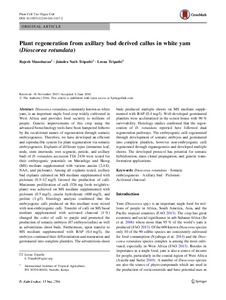| dc.contributor.author | Manoharan, R. |
| dc.contributor.author | Tripathi, J.N. |
| dc.contributor.author | Tripathi, L. |
| dc.date.accessioned | 2019-12-04T11:03:39Z |
| dc.date.available | 2019-12-04T11:03:39Z |
| dc.date.issued | 2016 |
| dc.identifier.citation | Manoharan, R., Tripathi, J., & Tripathi, L. (2016). Plant regeneration from axillary bud derived callus in white yam (Dioscorea rotundata). Plant Cell, Tissue and Organ Culture, |
| dc.identifier.issn | 0167-6857 |
| dc.identifier.uri | https://hdl.handle.net/20.500.12478/1180 |
| dc.description | Published online: 14 June 2016 |
| dc.description.abstract | Dioscorea rotundata, commonly known as white yam, is an important staple food crop widely cultivated in West Africa and provides food security to millions of people. Genetic improvements of this crop using the advanced biotechnology tools have been hampered hitherto by the recalcitrant nature of regeneration through somatic embryogenesis. Therefore, we have developed an efficient and reproducible system for plant regeneration via somatic embryogenesis. Explants of different types (immature leaf, node, stem internode, root segment, petiole, and axillary bud) of D. rotundata accession TDr 2436 were tested for their embryogenic potentials on Murashige and Skoog (MS) medium supplemented with various auxins (2,4-D, NAA, and picloram). Among all explants tested, axillary bud explants cultured on MS medium supplemented with picloram (0.5–12 mg/l) favored the production of calli. Maximum proliferation of calli (526 mg fresh weight/explant) was achieved on MS medium supplemented with picloram (0.5 mg/l), casein hydrolysate (600 mg/l), and proline (1 g/l). Histology analysis confirmed that the embryogenic calli produced on this medium were mixed with non-embryogenic calli. Transfer of calli on MS basal medium supplemented with activated charcoal (1 %) changed the color of calli to purple and promoted the production of somatic embryos (87 embryos/callus) as well as adventitious shoot buds. Furthermore, upon transfer to MS medium supplemented with BAP (0.4 mg/l), the embryos continued their differentiation and maturation and germinated into complete plantlets. The adventitious shoot buds produced multiple shoots on MS medium supplemented with BAP (0.4 mg/l). Well-developed germinated plantlets were acclimatized in the screen house with 90 % survivability. Histology studies confirmed that the regeneration of D. rotundata reported here followed dual regeneration pathways. The embryogenic calli regenerated through development of somatic embryos and germinated into complete plantlets, however non-embryogenic calli regenerated through organogenesis and developed multiple shoots. The developed protocol has potential for somatic hybridization, mass clonal propagation, and genetic transformation applications. |
| dc.format.extent | 1-17 |
| dc.language.iso | en |
| dc.subject | Dioscorea Rotundata |
| dc.subject | Somatic Embryogenesis |
| dc.subject | Picloram |
| dc.subject | Activated Charcoal |
| dc.subject | White Yam |
| dc.title | Plant regeneration from axillary bud derived callus in white yam (Dioscorea rotundata) |
| dc.type | Journal Article |
| dc.description.version | Peer Review |
| cg.contributor.crp | Roots, Tubers and Bananas |
| cg.contributor.affiliation | International Institute of Tropical Agriculture |
| cg.coverage.region | Africa |
| cg.coverage.region | West Africa |
| cg.coverage.country | Nigeria |
| cg.isijournal | ISI Journal |
| cg.authorship.types | CGIAR single centre |
| cg.iitasubject | Yam |
| cg.journal | Plant Cell, Tissue and Organ Culture |
| cg.howpublished | Formally Published |
| cg.accessibilitystatus | Open Access |
| local.dspaceid | 78369 |
| cg.targetaudience | Scientists |
| cg.identifier.doi | https://dx.doi.org/10.1007/s11240-016-1017-2 |

